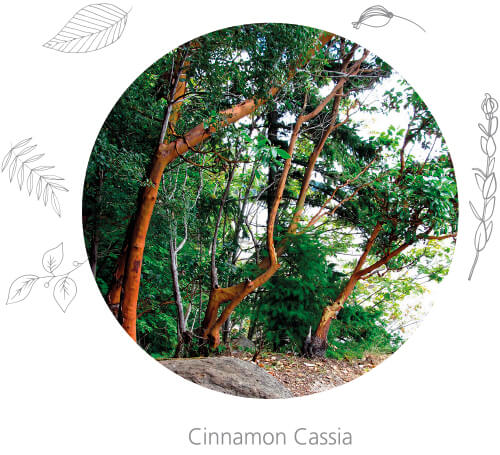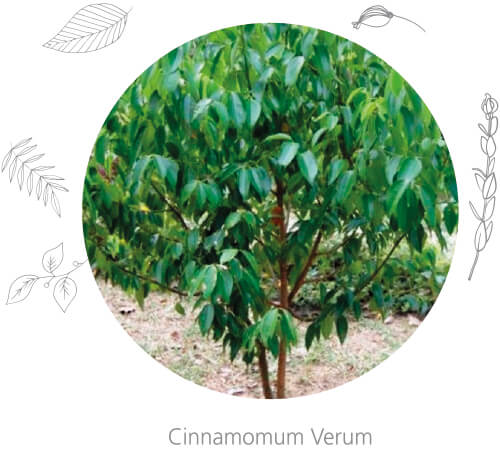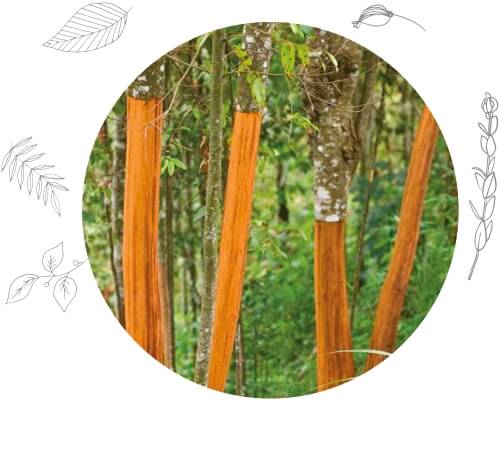-
Free Shipping in Greece over €30!

-
Shipping within 24 hours!

-
Worldwide shipping!



CASSIA
Cassia is an herb known since the ancient times. It is described by Herodotus and Theophrastos. It is one of the 147 herbs that Hippocrates used to treat various diseases. The most common pharmacological properties of cassia are the reduction of fat, the increase of fat burning, and the increase of the metabolism of sugars.
Names - Species
Cassia or Cinnamomum (Cinnamomum cassia), well-known and widely used in Ancient Greece, is a tree plant cultivated in South Asia and elsewhere. It is one of the many species of the genus Cinnamomum used mainly for its aromatic bark and for pharmaceutical purposes.
The main species of cassia are: Cinnamomum cassia, the most common species, Cinnamomum verum, Cinnamomum zeylanicum, Cinnamomum burmannii and Cinnamomum loureiroi.
The English word cinnamon, asserted in English since the 15th century, comes from the Ancient Greek "cinnamomon", through the intermediate forms of Latin and Medieval French.

Botanical Description
Cassia is a tree plant, one of the most ancient plants in the world. It belongs to Mongoliophyta, to the Lauraceae family. It includes more than 300 plant species. It is an evergreen tree with hard grey bark.
Its leaves are shiny green, oval-shaped, with intense ribbons, with more intense color on the upper side than on the bottom. The stem of the leaves is 1-2 centimeters long, has grooves on its upper surface. The younger leaves are red in color.
The flowers of the cassia are axillary and at the end of the branch they create an ear. The flower stem is creamy in color, slightly hairy, 5-7 cm long. Each flower is very small with diameter 3mm, pale yellow, with unpleasant aroma.
The fruit of the cassia is black, oval, fleshy, 1.5-2 cm long in full maturation, with an enlarged cup on the base and contains a seed. It is similar in size to a small olive tree.
The cassia we use is a thin layer of the inside of the bark of the tree that produces it. The bark is removed from the trunk and then scraped to remove its outer part and leave a 0.5 to 1.0 mm thick peel. It is cut into strips which are allowed to dry. Bark harvesting is preferred after rainfall, because it is easier to detach. The harvest season is between September and November.

History
Cassia is an herb known since the ancient times. The first Greek reference to the cassia is found in the 7th century BC, in a poem of Sappho. Herodotus mentions writers who believed that the source of cassia was the home of Dionysus, located somewhere east or south of Greece, while Theophrastus gives a very good description of the plant. Cassia is one of the 147 herbs most used by Hippocrates (one hundred and forty-seven herbal remedies) to cure various diseases.

Cinnamon cassia (with removed bark)
Pharmacological Properties
The most important pharmacological properties of cassia extract are the thermogenesis and the reduction the levels of sugars in a way that reduce fat deposition.
Cinnamaldehyde, the compound that gives the flavour and the aroma to cassia, increases the thermogenesis by which the fat metabolism (burning of the fat tissue) is activated.
Cassia increases insulin levels that lower the blood sugar levels - which cause fat storage - by reducing the after-meal intake glucose and delaying digestive tract emptying. This increase in insulin does not affect the feeling of fullness, i.e. it does not create a sense of hunger.
Additionally, cassia with its antioxidant and anti-inflammatory properties contributes to the improvement of the body functions, including metabolism.
Bibliography
1. Rahman S, Begum H, Rahman Z, Ara F, Iqbal MJ, Abukalam MY. Effect of cinnamon (Cinnamomum cassia) as a lipid lowering agent on hypercholesterolemic rats. J Enam Medical College. 2013;3:94–98.
2. Camacho S, Michlig S, De Senarclens-Bezençon C, Meylan J, Meystre J, Pezzoli M, et al. Antiobesity and anti-hyperglycemic effects of cinnamaldehyde via altered ghrelin secretion and functional impact on food intake and gastric emptying. Sci Rep. 2015;21:7919.
3. “Cinnamaldehyde induces fat cell-autonomous thermogenesis and metabolic reprogram-ming,” Juan Jiang, Jun Wu, et al., Metabolism — Clinical and Experimental, Volume 77, pp. 58–64.
4. “Oil from cinnamon drives fat cells to burn energy,” Emily Kagey, November 22nd, 2017, Futurity.
5. Tamura, Y., Iwasaki, Y., Narukawa, M., Watanabe, T. Ingestion of cinnamaldehyde, a TRPA1 agonist, reduces visceral fats in mice fed a high-fat and high-sucrose diet. J Nutr Sci Vitaminol (Tokyo). 2012;58:9–13.
6. Sartorius T, Peter A, Schulz N, Drescher A, Bergheim I, Machann J, et al. Cinnamon ex-tract improves insulin sensitivity in the brain and lowers liver fat in mouse models of obe-sity. PLoS One. 2014;9:e92358.
7. Ziegenfuss TM, Hofheins JE, Mendel RW. Effects of water soluble cinnamon extracts on body composition and features of the metabolic syndrome in prediabetic men and wom-en. J Int Soc Sports Nutr. 2006;3:45–53.
8. Vafa M, Mohammadi F, Shidfar F, Sormaghi MS, Heidari I, Golestan B, et al. Effects of cinnamon consumption on glycemic status, lipid profile and body composition in type 2 diabetic patients. Int J Prev Med. 2012;3:531–536.
9. Solomon TP, Blannin AK, “Changes in glucose tolerance and insulin sensitivity following 2 weeks of daily cinnamon ingestion in healthy humans”, Eur J Appl Physiol. Jan 22, 2009.
10. Priyanga Ranasinghe, Shehani Pigera, GA Sirimal Premakumara, Priyadarshani Galappath-thy, Godwin R Constantine and Prasad Katulanda. Medicinal properties of ‘true’ cinnamon (Cinnamomum zeylanicum): a systematic review. BMC Complement Altern Med. 2013; 13: 275.
11. Joanna Hlebowicz, Gassan Darwiche, Ola Björgell, and Lars-Olof Almér. Effect of cinna-mon on postprandial blood glucose, gastric emptying, and satiety in healthy subjects. Am J Clin Nutr June 2007, vol. 85 no. 6 1552-1556
12. Judy McBride, “Cinnamon Extract Spices Up Sugar Metabolism,” USDA News and Events, July 24, 2000.
13. Huang B, Yuan HD, Kimdo Y, Quan HY, Chung SH. Cinnamaldehyde prevents adipocyte differentiation and adipogenesis via regulation of peroxisome proliferator-activated recep-tor-gamma (PPARgamma) and AMP-activated protein kinase (AMPK) pathways. J Agric Food Chem. 2011;59:3666–3673.
14. Baker WLB, Gutiereez-Williams G, White CM, Kluger J, Coleman CI. The effect of cinna-mon on glucose control and lipid parameters. Diabetes Care 2008;31:41–3.
15. Broadhurst CL, Polansky MM, Anderson RA. Insulin-like biological activity of culinary and medical plant aqueous extracts in vitro. J Agric Food Chem 2000; 48: 849–52.
16. Anderson RA, Broadhurst CL, Polansky MM, et al. Isolation and characterization of poly-phenol type-A polymers from cinnamon with insulin-like biological activity. J Agric Food Chem 2004; 52: 65–70.
17. Alam Khan, Mahpara Safdar, Mohammad Muzaffar Ali Khan, Khan Nawaz Khattak, and Richard A. Anderson. Cinnamon Improves Glucose and Lipids of People With Type 2 Dia-betes. 10.2337/diacare.26.12.3215, Diabetes Care December 2003, vol. 26 no. 12 3215-3218.
18. Badalzadeh R, Shaghaghi M, Mohammadi M, Dehghan G, Mohammadi Z. The effect of cinnamon extract and long-term aerobic training on heart function, biochemical alterations and lipid profile following exhaustive exercise in male rats. Adv Pharm Bull. 2014;4:515–520.
19. Imparl-Radosevich J, Deas S, Polansky MM, et al. Regulation of PTP-1 and insulin recep-tor kinase by fractions from cinnamon: implications for cinnamon regulation of insulin signalling. Horm Res 1998; 50: 177–82.
20. Lee JS, Jeon SM, Park EM, Huh TL, Kwon OS, Lee MK, et al. Cinnamate supplementation enhances hepatic lipid metabolism and antioxidant defense systems in high cholesterol-fed rats. J Med Food. 2003;6:183–191.
21. Qin B, Nagasaki M, Ren M, Bajotto G, Oshida Y, Sato S. Cinnamon extract (traditional herb) potentiates in vivo insulin-regulated glucose utilazation via insulin-regulated glucose utilization via enhancing insulin signalin in rats. Diabetes Res Clin Pract 2003; 62: 3:139–48.
22. Qin B, Nagasaki M, Ren M, Bajotto G, Oshida Y, Sato S. Cinnamon extract prevents the insulin resistance induced by a high-fructose diet. Horm Metab Res 2004; 36: 119–25.
23. Verspohl EJ, Bauer K, Neddermann E. Antidiabetic effect of Cinnamomum cassia and Cin-namomum zelanicum in vivo and in vitro. Phytother Res 2005; 19: 203–6.
24. Jarvill-Taylor KJ, Anderson RA, Graves DJ: A hydroxychalcone derived from cinnamon functions as a mimetic for insulin in 3T3–L1 adipocytes. J Am Coll Nutr 20:327–336, 2001.
25. Eldar-Finkelman H, Krebs EG: Phosphorylation of insulin receptor substrate-1 by glycogen synthase kinase 3 impairs insulin action. Proc Natl Acad Sci 94:9660–9664, 1997.
26. Dhuley JN: Antioxidant effects of cinnamon (Cinnamomum verum) bark and greater car-damom (Amomum sabulatum) seeds in rats fed high fat diet. Indian J Exp Biol 37:238–242, 1999.
27. Mang B, Wolters M, Schmitt B, et al. Effect of a cinnamon extract on plasma glucose, HbA, and serum lipids in diabetes mellitus type 2. Eur J Clin Invest 2006;36:340–4.
28. Wang JG, Anderson RA, Graham GM, et al. The effect of cinnamon extract on insulin re-sistance parameters in polycystic ovary syndrome: a pilot study. Fertil Steril 2007;88:240–3.
29. Blevins SM, Leyva MJ, Brown J, Wright J, Scofield RH, Aston CE. Effect of cinnamon and lipid levels in non-insulin dependent type 2 diabetes mellitus. Diabetes Care 2007;30:2236–7.
30. Altschuler JA, Casella SM, MacKenzie TA, Curtis KM. The effect of cinnamon on A1C among adolescents with type 1 diabetes. Diabetes Care 2007;30:813–6.
31. Solomon TPJ, Blannin AK. Effects of short-term cinnamon ingestion on in vivo glucose tolerance. Diabetes Obes Metab 2007;9:895–901.
32. Pham AQ, Kourlas H, Pham DQ, “Cinnamon supplementation in patients with type 2 dia-betes mellitus,” Pharmacotherapy, Apr 2007 (vol 27, no. 4), pp. 595-99.
33. Dugoua JJ, Seely D, Perri D, Cooley K, Forelli T, Mills E, Koren G, “From type 2 diabetes to antioxidant activity: a systematic review of the safety and efficacy of common and cassia cinnamon bark,” Can J Physiol Pharmacol., Sep 2007 (vol. 85, no.9), pp. 837-47.
34. Tim N Ziegenfuss, Jennifer E Hofheins, Ronald W Mendel, Jamie Landis and Richard A An-derson, “Effects of a Water-Soluble Cinnamon Extract on Body Composition and Features of the Metabolic Syndrome in Pre-Diabetic Men and Women,” Journal of the International Society of Sports Nutrition 2006, 3:45-53.
35. Camacho, S., Michlig, S., de Senarclens-Bezencon, C., Meylan, J., Meystre, J., Pezzoli, M. et al, Anti-obesity and anti-hyperglycemic effects of cinnamaldehyde via altered ghrelin secretion and functional impact on food intake and gastric emptying. Sci Rep. 2015;5:7919.
36. Allen, R.W., Schwartzman, E., Baker, W.L., Coleman, C.I., Phung, O.J. Cinnamon use in type 2 diabetes: an updated systematic review and meta-analysis. Ann Fam Med. 2013;11:452–459.
37. Khare, P., Jagtap, S., Jain, Y., Baboota, R.K., Mangal, P., Boparai, R.K. et al, Cinnamal-dehyde supplementation prevents fasting-induced hyperphagia, lipid accumulation, and inflammation in high-fat diet-fed mice. Biofactors. 2016;42:201–211.
38. Zhao, H., Xie, Y., Yang, Q., Cao, Y., Tu, H., Cao, W. et al, Pharmacokinetic study of cinnamaldehyde in rats by GC-MS after oral and intravenous administration. J Pharm Bio-med Anal. 2014;89:150–157.
39. Jayaprakasha GK, Rao LJ. Chemistry, biogenesis, and biological activities of Cin-namomum zeylanicum. Crit Rev Food Sci Nutr. 2011;51:547–562.
40. Singh G, Maurya S, DeLampasona MP, Catalan CA. A comparison of chemical, antioxidant and antimicrobial studies of cinnamon leaf and bark volatile oils, oleoresins and their con-stituents. Food Chem Toxicol. 2007;45:1650–1661.
41. Senanayake UM, Lee TH, Wills RBH. Volatile constituents of cinnamon (Cinnamomum zeylanicum) oils. J Agric Food Chem. 1978;26:822–824.
42. Rao PV, Gan SH. Cinnamon: a multifaceted medicinal plant. Evid Based Complement Al-ternat Med. 2014:642942.
43. Ranasinghe P, Pigera S, Premakumara GA, Galappaththy P, Constantine GR, Katulanda P. Medicinal properties of ‘true’ cinnamon (Cinnamomum zeylanicum): a systematic review. BMC Complement Altern Med. 2013;13:275.
44. Aneja K, Joshi R, Sharma C. Antimicrobial activity of dalchini (Cinnamomum zeyancum bark) extracts on some dental caries pathogens. J Pharm Res. 2009;2:1387–1390.
45. Mathew S, Abraham TE. In vitro antioxidant activity and scavenging effects of Cin-namomum verum leaf extract assayed by different methodologies. Food Cheml Toxcol. 2006;44:198–206.
46. Couturier K, Batandier C, Awada M, Hininger-Favier I, Canini F, Anderson RA, et al. Cin-namon improves insulin sensitivity and alters the body composition in an animal model of the metabolic syndrome. Arch Biochem Biophys. 2010;501:158–161.
47. Shen Y, Jia LN, Honma N, Hosono T, Ariga T, Seki T. Beneficial effects of cinnamon on the metabolic syndrome, inflammation, and pain, and mechanisms underlying these ef-fects-a review. Tradit Complement Med. 2012;2:27–32.
48. Khan A, Bryden NA, Polansky MM, Anderson RA. Insulin potentiating factor and chromi-um content of selected foods and spices. Biol Trace Elem Res. 1990;24:183–188.
49. Sangal A. Role of cinnamon as beneficial antidiabetic food adjunct: a review. Adv Appl Sci Res. 2011;2:440–450.
50. Couturier K, Qin B, Batandier C, Awada M, Hininger-Favier I, Canini F, et al. Cinnamon increases liver glycogen in an animal model of insulin resistance. Metabolism. 2011;60:1590–1597.
51. Adisakwattana S, Lerdsuwankij O, Poputtachai U, Minipun A, Suparpprom C. Inhibitory activity of cinnamon bark species and their combination effect with acarbose against in-testinal α-glucosidase and pancreatic α-amylase. Plant Foods Hum Nutr. 2011;66:143–148.
52. Kreydiyyeh SI, Usta J, Copti R. Effect of cinnamon, clove and some of their constituents on the Na(+)-K(+)-ATPase activity and alanine absorption in the rat jejunum. Food Chem Toxicol. 2000;38:755–762.
53. Anderson RA, Broadhurst CL, Polansky MM, Schmidt WF, Khan A, Flanagan VP, et al. Iso-lation and characterization of polyphenol type-A polymers from cinnamon with insulin-like biological activity. J Agric Food Chem. 2004;52:65–70.
54. 33. Qin B, Nagasaki M, Ren M, Bajotto G, Oshida Y, Sato Y. Cinnamon extract (traditional herb) potentiates in vivo insulin-regulated glucose utilization via enhancing insulin signaling in rats. Diabetes Res Clin Pract. 2003;62:139–148.
55. Anderson RA, Broadhurst CL, Polansky MM, Schmidt WF, Khan A. Isolation and charac-terization of polyphenol type-A polymers from cinnamon with insulin-like biological activi-ty. J Agric Food Chem. 2004;52:65–70.
56. Im K, Issac A, Ninan E, Maliakel B, Kuttan R. Effects of the polyphenol content on the anti-diabetic activity of Cinnamomum zeylanicum extracts. Food Funct. 2014;5:2208–2220.
57. Blevins SM, Leyva MJ, Brown J, Wright J, Scofield RH, Aston CE. Effect of cinnamon on glucose and lipid levels in non-insulin-dependent type 2 diabetes. Diabetes Care. 2007;30:2236–2237.
58. Hafizur RM, Hameed A, Shukrana M, Raza SA, Chishti S, Kabir N, et al. Cinnamic acid ex-erts anti-diabetic activity by improving glucose tolerance in vivo and by stimulating insulin secretion in vitro. Phytomedicine. 2015;22:297–300.
59. Mang B, Wolters M, Schmitt B, Kelb K, Lichtinghagen R, Stichtenoth DO, et al. Effects of a cinnamon extract on plasma glucose, HbA, and serum lipids in diabetes mellitus type 2. Eur J Clin Invest. 2006;36:340–344.
60. Sheng X, Zhang Y, Gong Z, Huang C, Zang YQ. Improved insulin resistance and lipid me-tabolism by cinnamon extract through activation of peroxisome proliferator-activated re-ceptors. PPAR Res. 2008:581348.
61. Takasao N, Tsuji-Naito K, Ishikura S, Tamura A, Akagawa M. Cinnamon extract pro-motes type I collagen biosynthesis via activation of IGF-I signaling in human dermal fi-broblasts. J Agric Food Chem. 2012;60:1193–200.
62. Usta J, Kreydiyyeh S, Bajakian K, Nakkash-Chmaisse H. In vitro effect of eugenol and cinnamaldehyde on membrane potential and respiratory chain complexes in isolated rat liver mitochondria. Food Chem Toxicol. 2002;40:935–940.
63. Schriner SE, Kuramada S, Lopez TE, Truong S, Pham A, Jafari M. Extension of Drosophila lifespan by cinnamon through a sex-specific dependence on the insulin receptor substrate chico. Exp Gerontol. 2014;60:220–230.
64. Beejmohun V, Peytavy-Izard M, Mignon C, Muscente-Paque D, Deplanque X, Ripoll C, et al. Acute effect of Ceylon cinnamon extract on postprandial glycemia: alpha-amylase in-hibition, starch tolerance test in rats, and randomized crossover clinical trial in healthy volunteers. BMC Complement Altern Med. 2014;14:351–359.
65. Shen Y, Honma N, Kobayashi K, Jia LN, Hosono T, Shindo K, et al. Cinnamon extract en-hances glucose uptake in 3T3-L1 adipocytes and C2C12 myocytes by inducing LKB1-AMP-activated protein kinase signaling. PLoS One. 2014;9:e87894.
66. Peng X, Ma J, Chao J, Sun Z, Chang RC, Tse I, et al. Beneficial effects of cinnamon pro-anthocyanidins on the formation of specific advanced glycation endproducts and methyl-glyoxal-induced impairment on glucose consumption. J Agric Food Chem. 2010;58:6692–6696.
67. Ranasinghe P, Jayawardana R, Galappaththy P, Constantine GR, Gunawardana DV, Katu-landa P. Efficacy and safety of ‘true’ cinnamon (Cinnamomum zeylanicum) as a pharma-ceutical agent in diabetes: a systematic review and metaanalysis. Diabet Med Dec. 2012;29:1480–1492.
68. Crawford P. Effectiveness of cinnamon for lowering hemoglobin A1C in patients with type 2 diabetes: a randomized, controlled trial. J Am Board Fam Med. 2009;22:507–512. [PubMed]
69. Cao H, Polansky MM, Anderson RA. Cinnamon extract and polyphenols affect the expres-sion of tristetraprolin, insulin receptor, and glucose transporter 4 in mouse 3T3-L1 adipo-cytes. Arch Biochem Biophys. 2007;459:214–222.
70. Valko M, Leibfritz D, Moncola J, Cronin MTD, Mazura M, Telser J. Free radicals and anti-oxidants in normal physiological functions and human disease. Int J Biochem Cell Biol. 2007;39:44–84.
71. Dhuley JN. Anti-oxidant effects of cinnamon (Cinnamomum verum) bark and greater car-damon (Amomumsubulatum) seeds in rats fed high fat diet. Indian J Exp Biol. 1999;37:238–242.
72. Mancini-Filho J, van-Koiij A, Mancini DAP, Cozzolino F, Torres RP. Antioxidant activity of cinnamon (Cinnamomum zeylanicum breyne) extracts. Bollettino Chimico Farmaceutico. 1998;137:443–447.
73. Boğa M, Hacıbekiroğlu I, Kolak U. Antioxidant and anticholinesterase activities of eleven edible plants. Pharm Biol. 2011;49:290–295.
74. Aravind R, Aneesh T, Bindu A, Bindu K. Estimation of phenolics and evaluation of antioxi-dant activity of Cinnamomum malabatrum (Burm F) Blume Asian J Res Chem. 2012;5:628–632.
75. Chericoni S, Prieto JM, Iacopini P, Cioni P, Morelli I. In vitro activity of the essential oil of Cinnamomum zeylanicum and eugenol in peroxynitrite-induced oxidative processes. J Agric Food Chem. 2005;53:4762–4765.
76. Keshvari M, Asgary S, Jafarian-dehkordi A, Najafi S, Ghoreyshi-Yazdi S. M. Preventive ef-fect of cinnamon essential oil on lipid oxidation of vegetable oil. ARYA Atheroscler. 2013;9:280–286.
77. Kumar S, Vasudeva N, Sharma S. GC-MS analysis and screening of antidiabetic, antioxi-dant and hypolipidemic potential of Cinnamomum tamala oil in streptozotocin induced di-abetes mellitus in rats. Cardiovasc Diabetol. 2012;11:1–11.
78. Lee HS, Kim BS, Kim MK. Suppression effect of Cinnamomum cassia bark-derived com-ponent on nitric oxide synthase. J Agric Food Chem. 2002;50:7700–7703.Roussel AM, Hininger I, Benaraba R, Ziegenfuss TN, Anderson RA. Antioxidant effects of a cinnamon extract in people with impaired fasting glucose that are overweight or obese. J Am Coll Nutr. 2009;28:16–21.
79. Pandey M, Chandra DR. Evaluation of Ethanol and Aqueous extracts of Cinnamomum verum Leaf Galls for Potential Antioxidant and Analgesic activity. Indian J Pharm Sci. 2015;77:243–247.
80. Moselhy SS, Ali HK. Hepatoprotective effect of cinnamon extracts against carbon tetra-chloride induced oxidative stress and liver injury in rats. Biol Res. 2009;42:993–998.
81. Akilen R, Pimlott Z, Tsiami A, Robinson N. Effect of short-term administration of cinna-mon on blood pressure in patients with prediabetes and type 2 diabetes. Nutrition. 2013;29:1192–1196.
82. Akilen R, Tsiami A, Devendra D, Robinson N. Glycated haemoglobin and blood pressure-lowering effect of cinnamon in multi-ethnic Type 2 diabetic patients in the UK: a random-ized, placebo-controlled, double-blind clinical trial. Diabet Med. 2010;27:1159–1167.
83. Alvarez-Collazo J, Alonso-Carbajo L, López-Medina AI, Alpizar YA, Tajada S, Voetes T, et al. Cinnamaldehyde inhibits L-type calcium channels in mouse ventricular cardiomyocytes and vascular smooth muscle cells. Pflugers Arch. 2014;466:2089–2099.
84. Nyadjeu P, Dongmo A, Nguelefack TB, Kamanyi A. Antihypertensive and vasorelaxant effects of Cinnamomum zeylanicum stem bark aqueous extract in rats. J Complement In-tegr Med. 2011 doi:10.2202/1553-3840.1490.
85. Nyadjeu P, Nguelefack-Mbuyo EP, Atsamo AD, Nguelefack TB, Dongmo AB, Kamanyi A. Acute and chronic antihypertensive effects of Cinnamomum zeylanicum stem bark meth-anol extract in L-NAME-induced hypertensive rats. BMC Complement Altern Med. 2013;31:13–27.
86. El-Bassossy HM, Fahmy A, Badawy D. Cinnamaldehyde protects from the hypertension associated with diabetes. Food Chem Toxicol. 2011;49:3007–3012.
87. Ko FN, Yu SM, Kang YF, Teng CM. Characterization of the thromboxane (TP-) receptor subtype involved in proliferation in cultured vascular smooth muscle cells of rat. Br J Pharmacol. 1995;116:1801–1808.
88. Yu SM, Wu TS, Teng CM. Pharmacological characterization of cinnamophilin, a novel dual inhibitor of thromboxane synthase and thromboxane A2 receptor. Br J Pharmacol. 1994;111:906–912.
89. Hwa JS, Jin YC, Lee YS, Ko YS, Kim YM, Shi LY, HJ Kim, JH Lee, TM Ngoc, YS Kim, KC Chang, et al. 2-Methoxycinnamaldehyde from Cinnamomum cassia reduces ratmyocardial ischemia and reperfusion injury in vivo due to HO-1 induction. J Ethnopharmacol. 2012;139:605–615.
90. Song F, Li H, Sun J, Wang S. Protective effects of cinnamic acid and cinnamic aldehyde on isoproterenol-induced acute myocardial ischemia in rats. J Ethnopharmacol. 2013;150:125–130.
91. Badalzadeh R, Shaghaghi M, Mohammadi M, Dehghan G, Mohammadi Z. The effect of cinnamon extract and long-term aerobic training on heart function, biochemical alterations and lipid profile following exhaustive exercise in male rats. Adv Pharm Bull. 2014;4:515–520.
92. Muhammad JS, Zaidi SF, Shaharyar S, Refaat A, Usmanghani K, Saiki I, et al. Anti-inflammatory effect of cinnamaldehyde in Helicobacter pylori induced gastric inflamma-tion. Biol Pharm Bull. 2015;38:109–115.
93. Mashhadi NS, Ghiasvand R, Askari G, Feizi A, Hariri M, Darvishi L, et al. Influence of gin-ger and cinnamon intake on inflammation and muscle soreness endued by exercise in Iranian female athletes. Int J Prev Med. 2013;4:11–15.
94. Muhammad JS, Zaidi SF, Shaharyar S, Refaat A, Usmanghani K, Saiki I, et al. Anti-inflammatory effect of cinnamaldehyde in Helicobacter pylori induced gastric inflamma-tion. Biol Pharm Bull. 2015;38:109–115.
95. Yu T, Lee S, Yang WS, Jang HJ, Lee YJ, Cho NY. The ability of an ethanol extract of Cin-namomum cassia to inhibit Src and spleen tyrosine kinase activity contributes to its anti-inflammatory action. J Ethnopharmacol. 2012;139:566–573.
96. Lee BJ, Kim YJ, Cho DH, Sohn NW, Kang H. Immunomodulatory effect of water extract of cinnamon on anti-CD3-induced cytokine responses and p38, JNK, ERK1/2, and STAT4 activation. Immunopharmacol Immunotoxicol. 2011;33:714–722.
97. Hong JW, Yang GE, Kim YB, Eom SH, Lew JH, Kang H. Anti-inflammatory activity of cin-namon water extract in vivo and in vitro LPS-inducedmodels. BMC Complement Altern Med. 2012;12:237.
98. Bolin Q, Anderson R. Cinnamon polyphenols increase oxygen-glucose deprivation of de-creased PGE2 production by upregulation of SIRT1 and alleviation of the anti-inflammatory effects (830.11) FASEB. 2014;28:830–841.
99. Chao LK, Hua KF, Hsu HY, Cheng SS, Lin IF, Chen CJ, et al. Cinnamaldehyde inhibits pro-inflammatory cytokines secretion from monocytes/macrophages through suppression of intracellular signaling. Food Chem Toxicol. 2008;46:220–231.
100. Huang SH, Choi YG, Jeong MY, Hong YM, Lee JH, Lim S. Microarray analysis of gene expression profile by treatment of Cinnamomi ramulus in lipopolysaccharide estimulated BV-2 cells. Gene. 2009;443:83–90.
101. Gunawardena D, Karunaweera N, Lee S, Van Der Kooy F, Harman DG, Raju R, et al. Anti-inflammatory activity of cinnamon (C. zeylanicum and C. cassia) extracts –identification of E-cinnamaldehyde and o-methoxy cinnamaldehyde as the most potent bioactive com-pounds. Food Funct. 2015;6:910–919.
102. Rathi B, Bodhankar S, Mohan V, Thakurdesai P. Ameliorative effects of a polyphenolic fraction of Cinnamomum zeylanicum L bark in animal models of inflammation and arthri-tis. Sci Pharm. 2013;81:567–589.
103. Lu J, Zhang K, Nam S, Anderson RA, Jove R, Wen W. Novel angiogenesis inhibitory activ-ity in cinnamon extract blocks VEGFR2 kinase and downstream signaling. Carcinogenesis. 2010;31:481–488.
104. Ross R, Després JP. Abdominal obesity, insulin resistance, and the metabolic syndrome: contribution of physical activity/exercise. Obesity. 2009;17:S1–S2.
105. Takemoto K, Deckelbaum RJ, Saito I, Likitmaskul S, Morandi A, Pinelli L, et al. Adiponec-tin/resistin levels and insulin resistance in children: a four country comparison study. Int J Pediatr Endocrinol. 2015;2015:2.
106. Kim SH, Choung SY. Antihyperglycemic and antihyperlipidemic action of Cinnamomi cas-siae (Cinnamon bark) extract in C57BL/Ks db/db mice. Arch Pharm Res. 2010;33:325–333.
107. Khan A, Safdar M, Ali Khan MM, Khattak KN, Anderson RA. Cinnamon improves glucose and lipids of people with type 2 diabetes. Diabetes Care. 2003;26:3215–3218.
108. Shatwan IA, Ahmed LA, Badkook MM. Effect of barley flour, crude cinnamon, and their combination on glycemia, dyslipidemia, and adipose tissue hormones in type 2 diabetic rats. J Med Food. 2013;16:656–662.
109. Javed I, Faisal I, Rahman Z, Khan MZ, Muhammad F, Aslam B, et al. Lipid lowering effect of Cinnamomum zeylanicum in hyperlipidaemic albino rabbits. Pak J Pharm Sci. 2012;25:141–147.
110. Jin S, Cho KH. Water extracts of cinnamon and clove exhibits potent inhibition of protein glycation and anti-atherosclerotic activity in vitro and in vivo hypolipidemic activity in zebrafish. Food Chem Toxicol. 2011;49:1521–1529.













